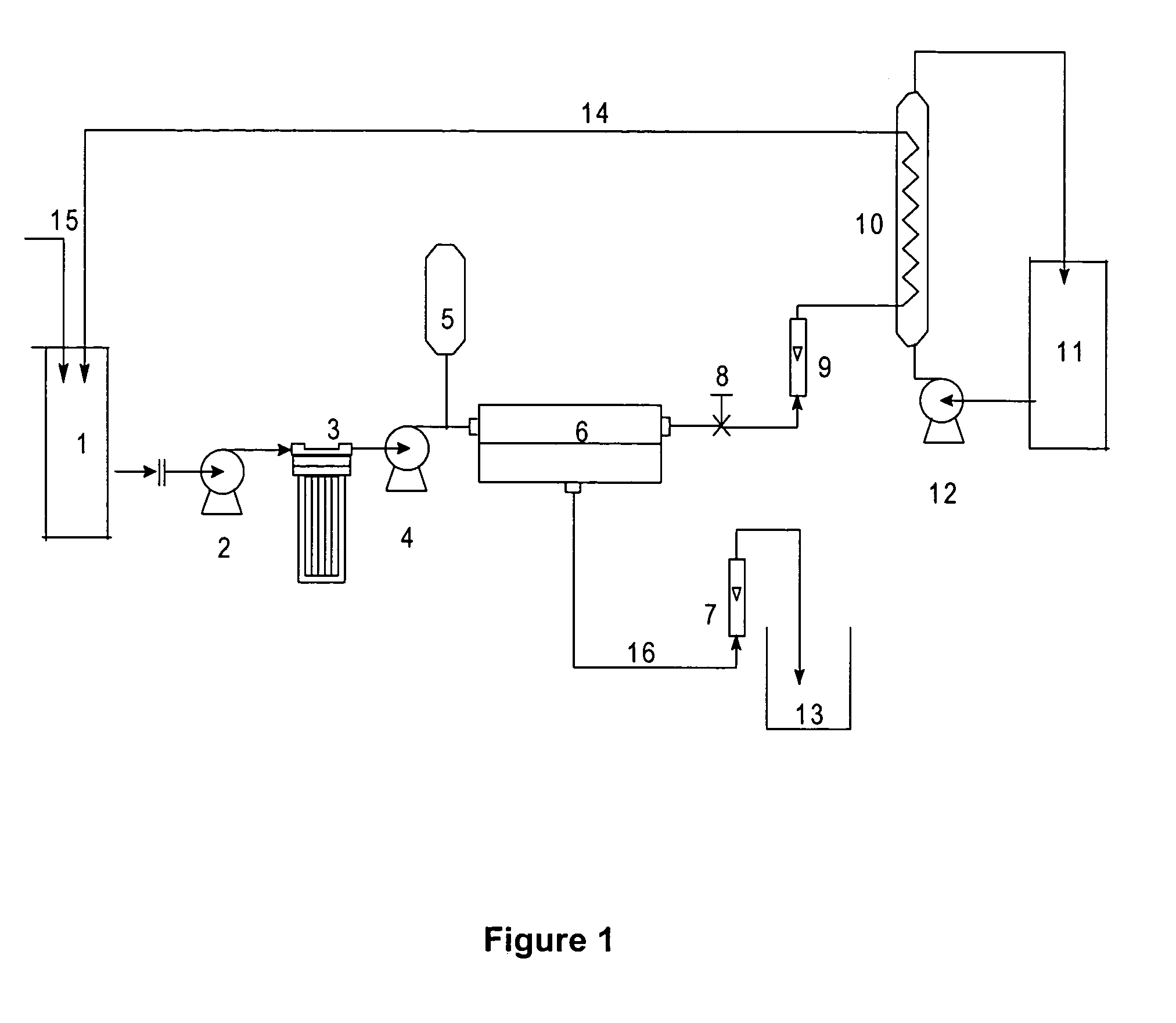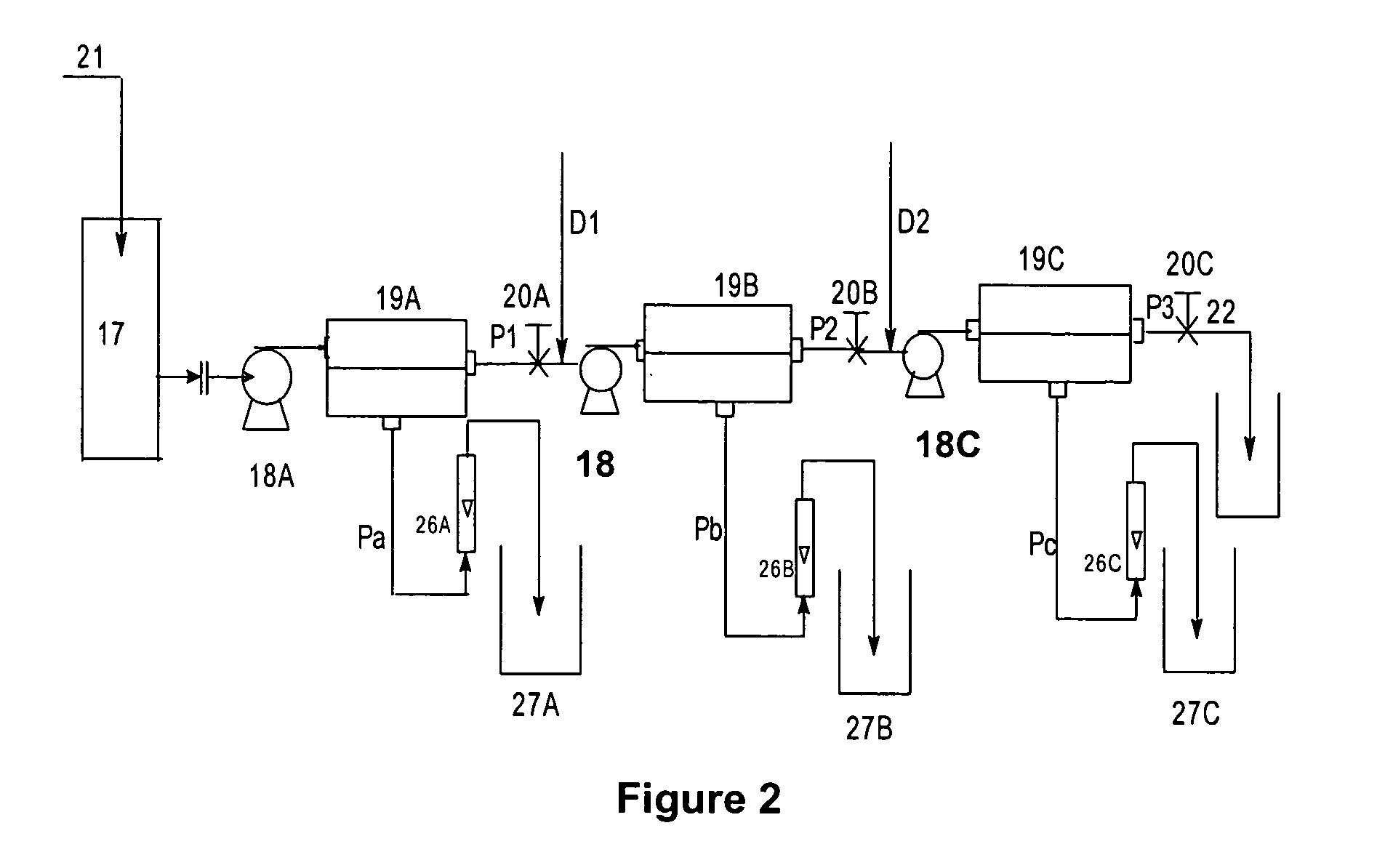Recovery of sodium thiocyanate from industrial process solution using nanofiltration technique
a technology of industrial process solution and nanofiltration technology, which is applied in the direction of thiocyanic acid, reverse osmosis, chemistry apparatus and processes, etc., can solve the problems of increasing the electrical resistance of cells, and reducing the recovery rate of sodium thiocyanate. , to achieve the effect of reducing the color of the permeate solution, reducing the cost of treatment and removal, and facilitating the maximum recovery
- Summary
- Abstract
- Description
- Claims
- Application Information
AI Technical Summary
Benefits of technology
Problems solved by technology
Method used
Image
Examples
example 1
[0066]A batch of 50 liters containing 135.1 gpl of NaSCN at 30.degree. C. was fed to feed tank 1. High-pressure pump, 4, was turned on and the pressure on the feed side was maintained at 21 bar throughout the run. The feed was processed through a Cellulose triacetate membrane, 23, and following the run, permeate was collected in separate tank over a period of 86 minutes. The pass stream flow rate was kept constant at 17 liters per minute. A recovery of 60% was collected as permeate volume with an average flux between 28 lit.m.sup.−2.hr.sup.−1 and 29 lit.m.sup.−2.hr.sup.−1. The color and impurity rejections were found to be 76.5% and 66.4% respectively. The feed, pass and permeate samples were analyzed for NaSCN and color and the results are tabulated in table 1 given below.
[0067]
TABLE 1Quality parametersFeedPermeatePassNaSCN(%)13.5116.8811.27% Total impurities5.543.179.42Color APHA9823209
example 2
[0068]A batch of 30 liters of feed solution containing 129 gpl of sodium thiocyanate is diluted in the ratio 1:0.5, reducing the concentration of sodium thiocyanate to 86 gpl, thereby making the volume to 45 liters and was fed to feed tank, 17, at a temperature of 28.degree. C. High pressure pump, 18A, was turned on and the pressure on the feed side was adjusted to 24 bar using pressure control valve 20A and was maintained constant during the run. The feed was processed through a polyamide (PA-300), 24, spiral wound membrane module 19A. The pass stream flow rate was kept constant at 17 liters per minute whereas the permeate flow rate 26A varied during the run. 27 liters of permeate volume was collected in a separate tank 27A over a period of 254 minutes for a volume recovery of 60%. The impurity and color rejections were found to be 94% and 97% respectively. The remaining 18 liters was left in the tank and within the system. The feed stream, pass stream and permeate stream are analy...
example 3
[0070]In this Example, the pass stream P1 of Example 2 was diluted with distilled water in the ratio 1:0.5 and a total volume of 30 liters containing 37.3 gpl of NaSCN was run through a polyamide membrane module 19B. Pressure on the feed side was adjusted to 24 bar using pressure control valve 20B and was maintained constant during the run. The pass stream flow rate was constant during the run at 17 liters per minute. 15 liters of the permeate was collected for a duration of 172 minutes obtaining an overall volume recovery of 50%. The impurity and color rejections were found to be 95% and 98% respectively. The feed stream, pass stream and permeate stream were analyzed for % NaSCN, % total impurities and color and results are tabulated in Table 3.
[0071]
TABLE 3Quality ParametersFeedPermeatePassNaSCN Conc (%)3.735.32.57Total impurities (%)6.260.6711.13βSPA (%)0.140.080.27βSPN (%)0.100.060.32Na2SO45.690.4210.14NaCl (%)0.070.030.07Ca(ppm)80.611.65155Color(APHA units)2393.0447
PUM
| Property | Measurement | Unit |
|---|---|---|
| area | aaaaa | aaaaa |
| pressures | aaaaa | aaaaa |
| pressures | aaaaa | aaaaa |
Abstract
Description
Claims
Application Information
 Login to View More
Login to View More - R&D
- Intellectual Property
- Life Sciences
- Materials
- Tech Scout
- Unparalleled Data Quality
- Higher Quality Content
- 60% Fewer Hallucinations
Browse by: Latest US Patents, China's latest patents, Technical Efficacy Thesaurus, Application Domain, Technology Topic, Popular Technical Reports.
© 2025 PatSnap. All rights reserved.Legal|Privacy policy|Modern Slavery Act Transparency Statement|Sitemap|About US| Contact US: help@patsnap.com



